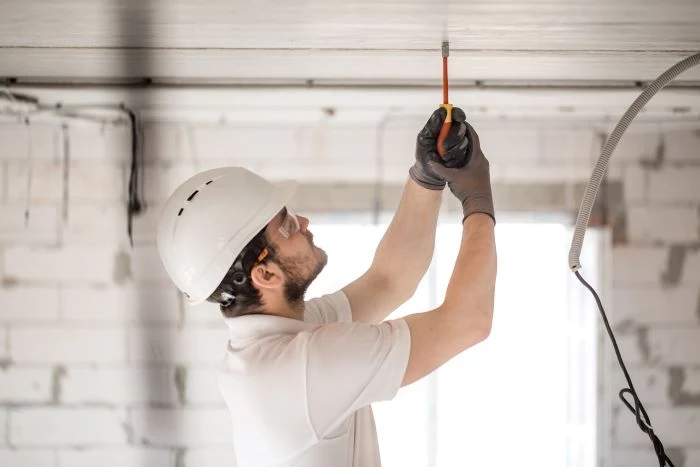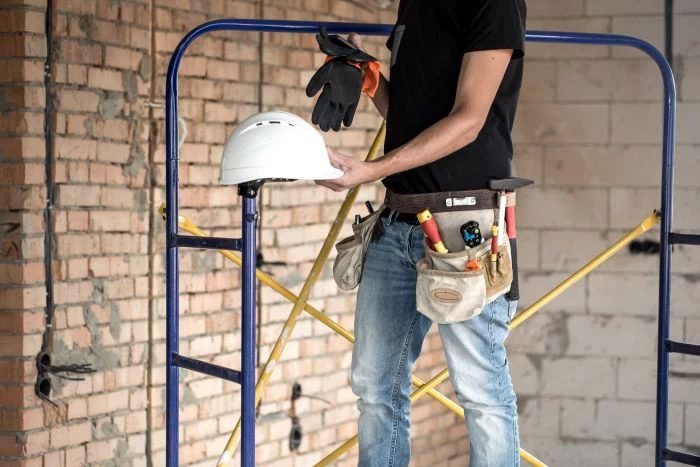How to Hire a Remodeling Contractor and Not Get Burned
I’ve spent my entire career in the building trades. I started out swinging a hammer and eventually ended up running my own remodeling company. In that time, I’ve seen some absolutely breathtaking work, the kind that looks amazing for decades. I’ve also been the guy called in to fix the disasters—the ones that drain a family’s savings and shatter their peace of mind. And honestly, the difference almost always boils down to one thing: the quality of the contractor they hired.
In this article
Hiring a remodeler isn’t like grabbing a new TV off the shelf. You’re choosing a partner who will be inside your home, in your personal space, for weeks or even months. This person and their crew will be tearing down your walls, messing with your plumbing, and wiring your electricity. That’s a huge deal. Your family’s safety and your home’s value are literally in their hands.
This decision deserves a solid, methodical approach. So I want to share the exact process I use and teach to others in the business. This isn’t about finding the cheapest price tag. It’s about finding the right professional for your project.

First Things First: Your Pre-Game Plan
I get it. You’ve been dreaming about this project, and you’re itching to start calling people and getting quotes. But hold on for just a minute. The most successful projects always start with careful planning on your part. Doing this homework first will save you time, money, and a boatload of headaches. Plus, it helps the good contractors give you a much more accurate price.
Define Your Scope (Like, REALLY Define It)
You’ve got to know what you want before you can ask someone to build it. “Redo the kitchen” is a wish, not a plan. A pro needs the nitty-gritty details. Sit down and make a list of everything you want to accomplish. Be almost painfully specific.
- Are you taking out a wall? Do you have any idea if it’s load-bearing?
- What exact flooring do you want? Don’t just say “wood floors.” Say “3/4-inch solid white oak” or “Aquaguard brand luxury vinyl plank in ‘Calypso Oak’.”
- What level of cabinets are you expecting? Custom-built by a local woodworker, semi-custom from a kitchen supplier, or stock cabinets from Home Depot? These have wildly different price points.
- List out all the new appliances you plan to buy, with model numbers if you have them.
- Get detailed about the lighting. For example: “four 4-inch recessed LED lights on a dimmer switch, and two pendant lights over the island.”
The more detailed your list, the better your bids will be. By the way, here’s a good rule of thumb: if you’re moving walls, changing the roofline, or putting on an addition, you should probably hire an architect or a designer first. They create the detailed drawings that are the universal language for builders. If you’re just replacing things in the same spot (like cabinets, flooring, or bathroom fixtures), a good design-build contractor can often handle the planning just fine.

Get Real About Your Budget
Here’s a hard truth: a remodel almost always costs more than you think. It just does. Materials have hidden costs, and you never know what you’ll find when you open up a wall. I once discovered massive termite damage hidden behind a perfectly normal-looking wall in an older home. The client hadn’t budgeted for that kind of major structural repair, and it added thousands to the project cost.
This is why you absolutely need a contingency fund. This is extra cash, set aside purely for the unexpected. I always tell my clients to have 15% to 20% of the total project cost in reserve. So, if your bids are coming in around $50,000, you need to have an extra $7,500 to $10,000 sitting in the bank. If you don’t end up needing it, fantastic! You can buy a fancy new couch. But if you do need it, it’ll save your project from stalling out.

Your homework for today: Open a new savings account and name it “Remodel Contingency Fund.” Seriously, do it. Put $100 in it. Getting it started makes it real and builds a crucial habit.
Finding the Right People (And Weeding Out the Wrong Ones)
Okay, with your plan and budget in hand, you can start the hunt. But please, don’t just Google “remodelers near me” and call the first three. You’re looking for a qualified pro, not a pizza delivery service. Your goal here is to build a short list of three to four solid candidates.
Where the Pros Find Pros
The best leads come from other people in the trades. They know who’s reliable and who to avoid.
- Architects and Designers: They work with builders all the time and won’t risk their reputation by recommending someone who does sloppy work.
- Building Material Suppliers: Go to a real local lumberyard or a high-end tile shop (not a big-box store). Find the manager at the pro desk and ask who they’d recommend. They know which contractors pay their bills on time and which ones consistently buy quality materials.
- Building Inspectors: This is a lesser-known trick. While they can’t officially endorse anyone, you can sometimes ask them which companies’ job sites are always clean and consistently pass inspections. Their off-the-record insights are gold.
- Word of Mouth: Of course, ask friends and neighbors. But don’t just take their word for it. Insist on seeing the finished project. Ask them about the process, not just the final result. Were they on time? Was the communication good? Was the crew respectful of their home?
Oh yeah, and try this: drive around neighborhoods you like and look for job sites. A clean, organized site with safety measures in place is a huge green flag. A chaotic mess with trash everywhere is a billboard-sized red flag.

The Non-Negotiable Step: Verifying License and Insurance
Do. Not. Skip. This. Step. A legitimate contractor will have zero problem providing this information. If anyone gives you the runaround or gets defensive, you walk away. End of story.
License Check: A license means a contractor has proven a baseline of knowledge to the state. To verify it, go to Google right now and search for “[Your State] contractor license lookup.” The official government site should be the first result. Bookmark it. You can search by their name or license number to see if it’s active and if there are any complaints against them.
Insurance Verification: A pro needs two kinds of insurance. You need to see the paperwork for both.
- General Liability: This covers damage to your property. If a worker drops a hammer and cracks your new tub, this is what pays for it. Look for a policy with at least $1 million in coverage—$2 million for bigger jobs.
- Workers’ Compensation: This is the big one. It covers injuries to the contractor or their employees on your property. If they don’t have it and someone falls off a ladder, you could be sued for their medical bills.
Quick tip: Don’t just glance at the certificate they hand you. Call the insurance agency listed on the form to verify the policy is still active. A mini-script for this call, so you don’t feel awkward: “Hi, I’m a potential client of [Contractor Name], and I’m just doing my due diligence. Can you please confirm that policy number [Policy #] for General Liability is currently active?” It’s a two-minute call that can save you from a complete nightmare.

The Interview: Reading Between the Lines
Now it’s time to meet your short-listed candidates. Remember, this is a two-way interview. They’re checking out your project, and you’re evaluating their professionalism, communication style, and expertise.
Key Questions to Ask
- How long have you been in business under this name? Stability is a good sign. Companies that frequently change names might be running from a bad reputation.
- Who will be my main point of contact? You need one person who is accountable. You don’t want to be chasing down random crew members for answers.
- Do you use your own employees or subcontractors? Either can be fine, but you need to know. If they use subs, ask how they vet them and if they require them to have their own insurance.
- What’s the typical budget and scope for your projects? Make sure your job is a good fit. A contractor who usually does $500,000 additions might not give your $25,000 bathroom the attention it deserves.
- Can you provide three recent references for projects similar to mine? A confident pro will have this list ready to go.
How to Actually Check Those References
Don’t just ask, “Were you happy?” Dig deeper to get the real story.
- “How did the contractor handle problems or changes?” (Because problems always happen.)
- “Was the project completed on schedule and on budget?”
- “How was the day-to-day communication?”
- “Was the job site kept clean and safe?”
- “Would you hire them again?” (This is the most telling question of all.)
And here’s a pro move: ask the reference if they’d be willing to text or email you a couple of photos of the finished work. Seeing the quality of the paint lines or tile grout for yourself is invaluable.
Decoding the Paperwork: Bids & Contracts
After the interviews, you’ll get bids from your top choices. Comparing them is about way more than just the bottom-line number.
What a Good Bid Looks Like (vs. a Red Flag)
First, let’s talk about what to run away from. A red-flag bid is often a single page with a vague description like “Kitchen Remodel” and a single lump-sum price. It’s a sign of either laziness or, worse, an attempt to hide costs and leave room for endless upcharges. There’s no way to compare this kind of bid to another one because you have no idea what it actually includes.
Now, here’s what you want to see. A professional bid is a detailed document, often several pages long. It breaks down the project into a clear scope of work with line items for labor and materials. It should specify the exact types and grades of materials—not just “install new window,” but “install one Andersen 400 Series double-hung window, 36×48 inches.” It should also include a clear payment schedule and list out any “allowances” (placeholder budgets for things like tile or light fixtures) and explain how those numbers were calculated.
The Contract Is Your Shield
Once you choose your contractor, get a solid contract. Do not, under any circumstances, start work on a handshake agreement. The contract should include everything from the detailed bid, plus a few other critical items:
- A Change Order Process: A clear, written procedure for how changes are approved and priced.
- Start and Completion Dates: These should be realistic estimates.
- Warranty Information: A one-year warranty on labor is pretty standard.
- Lien Waivers: This is HUGE. This clause requires the contractor to give you proof that they’ve paid their suppliers and subcontractors before you make your final payment. I once saw a homeowner have to pay $10,000 for their kitchen cabinets a second time because their contractor pocketed the money and never paid the cabinet company. A lien waiver prevents this exact scenario.
Heads up! A huge down payment request is a major red flag. In some states, it’s illegal for a contractor to ask for more than 10% or $1,000, whichever is less. Check your local laws, but be very wary of anyone asking for 30-50% upfront. It often means they’re having cash flow problems.
A Quick Reality Check on Timelines
Homeowners are often shocked by how long things actually take. So you can set your expectations, here are some very rough ballpark timelines for common projects, from start to finish:
- Small Bathroom Remodel (no layout changes): 2 to 4 weeks
- Full Kitchen Gut and Remodel: 6 to 12 weeks, sometimes longer
- Finishing a Basement (approx. 1,000 sq ft): 4 to 8 weeks
Remember, these are just averages! Getting permits, waiting for custom materials, supply chain delays, and any changes you make along the way can easily add weeks to your project.
A Final Gut Check
Throughout this whole process, from the first call to the final signature, trust your intuition. You’re forming a relationship. If a contractor is a poor communicator, talks down to you, or just makes you feel uneasy, it doesn’t matter how pretty their portfolio is. The stress of working with them will sour the entire experience.
Choosing the right remodeler is a big decision, but it doesn’t have to be terrifying. If you follow a structured, professional process, you can protect your investment and create a home you’ll be proud of for years to come. Take your time, do the research, and vet them like a pro. The peace of mind is absolutely worth it.










